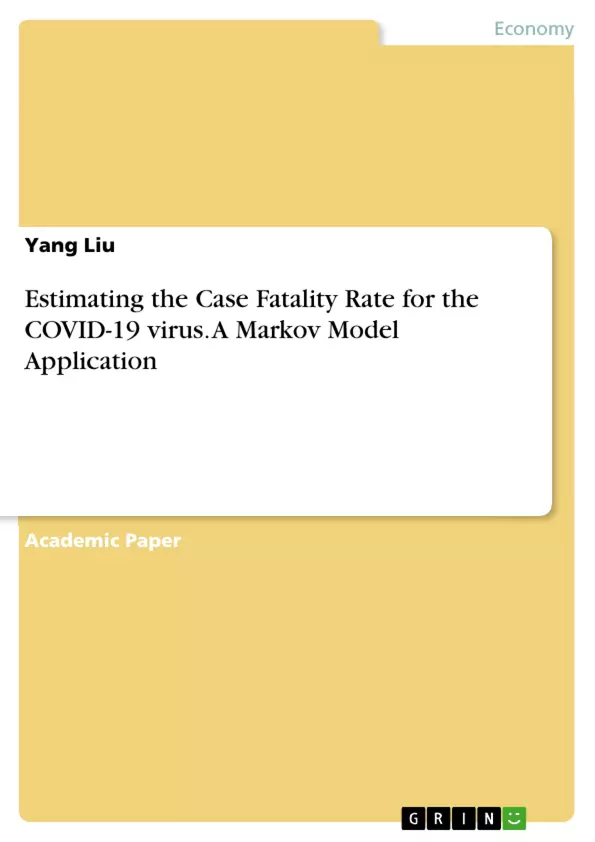Europe has became the new epicentre of the COVID-19 pandemic, according to the WHO on 13th March 2020. Sums and ratios of death and confirmed cases were reported daily, however, such statistics vary significantly by country and it is therefore challenging to understand and measure the risk and severity of the novel disease. Prior to the European outbreak, the COVID-19 virus infected more than 80,000 people in China since late 2019 and took the life of several thousands during the past few months.
In this paper, a 3-state model Markov model is applied on the data from China to study the dynamics of the disease and the impact of containment strategies. The long-run stable transition probability obtained from the Markov model provides a convenient approach to estimate the case fatality rate of the COVID-19. Also, the estimated life expectancy give a reasonable estimate of time between first symptom and death.
Considering the containment strategy implemented in China, the analysis is done for Hubei province and the rest of China respectively. Comparison of daily estimated results over the whole observation period highlight the impact of the strategy while supporting the measures and controls in place.
The proposed Markov model produce reasonable and intuitive estimates that help to measure the virulence of the disease and understand the prevalence overtime. While uncertainty persists as the pandemic goes on, our results show that the Markov approaches provide a useful tool for prognosis and epidemic control.
Inhaltsverzeichnis (Table of Contents)
- Motivation
- Markov Chain Models
- Application to COVID-19 data
- Data
- Case Fatality Rate (CFR)
- Methodology and assumptions
- Discussion
Zielsetzung und Themenschwerpunkte (Objectives and Key Themes)
This paper utilizes a 3-state Markov model to analyze the dynamics of the COVID-19 disease outbreak in China. The model's long-run stable transition probability is used to estimate the case fatality rate (CFR) and the estimated life expectancy provides an approximation of the time between first symptom and death. The study examines the impact of containment strategies implemented in China, focusing on both Hubei province and the rest of China.
- Estimating the case fatality rate (CFR) of COVID-19.
- Analyzing the dynamics of the disease outbreak in China.
- Assessing the impact of containment strategies on the disease spread.
- Evaluating the effectiveness of the Markov model as a tool for prognosis and epidemic control.
- Comparing the CFR and disease severity between Hubei and other regions of China.
Zusammenfassung der Kapitel (Chapter Summaries)
- Motivation: This chapter outlines the background of the COVID-19 pandemic, emphasizing the need for robust measures to understand its trends and provide prognoses. It also introduces the data used in the study, specifically focusing on daily reported onset, recovery, and death cases from the World Health Organization (WHO).
- Markov Chain Models: This chapter introduces the fundamental concepts and assumptions of discrete multi-state Markov models, focusing on their application to real-world data during the COVID-19 pandemic. It describes the quantitative estimation of transition intensity and probability between onset, recovery, and death states. The chapter also explains how the estimated probability transition matrix can be used to calculate single-period and long-run cumulative probabilities of transitioning from the onset state to recovery or death.
- Application to COVID-19 data: This chapter details the study's application of the Markov model to COVID-19 data from China, including Hubei province and the rest of the country. It examines the daily reported confirmed, dead, and recovered cases, highlighting the observed trends and supporting the assumption that the epidemic situation is under control. The chapter then discusses the concept of the case fatality rate (CFR) and the challenges in calculating an accurate CFR during an ongoing pandemic.
Schlüsselwörter (Keywords)
The core concepts and themes explored in this paper include the Markov model, the COVID-19 pandemic, the case fatality rate, disease dynamics, containment strategies, and the effectiveness of quantitative methods in understanding and controlling infectious diseases. The study also highlights the importance of data analysis and modeling in providing insights into the severity and progression of the virus, as well as the impact of various interventions.
- Citation du texte
- Yang Liu (Auteur), 2020, Estimating the Case Fatality Rate for the COVID-19 virus. A Markov Model Application, Munich, GRIN Verlag, https://www.grin.com/document/923168



